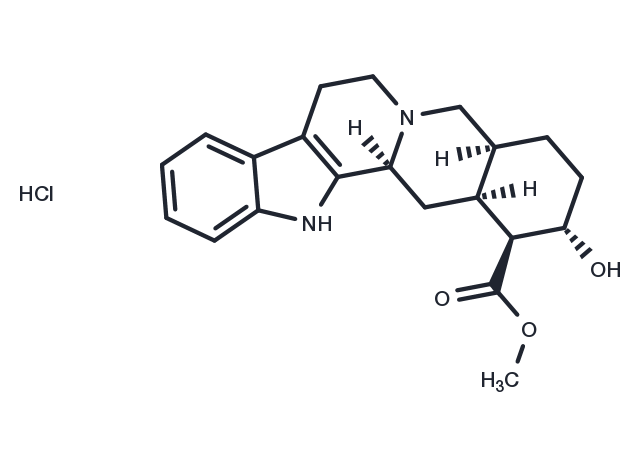Powder: -20°C for 3 years | In solvent: -80°C for 1 year


Rauwolscine hydrochloride (Isoyohimbine hydrochloride) , a natural alkaloid, is a specific and reversible α2-adrenergic receptor antagonist (Ki: 12 nM) [1]. It is a stereoisomer of yohimbine, which potently antagonizes both α1- and α2-adrenergic receptors [1]. Rauwolscine hydrochloride also acts as a receptor antagonist at the serotonin 5-HT2B receptor (Ki: 14.3 nM) and as a weak partial agonist at 5-HT1A (IC50: 1.3 μM) [3]. The α2-adrenergic receptor has diverse physiological functions and antagonists like rauwolscine have numerous applications, including the modulation of mood and behavior [5].

| Pack Size | Availability | Price/USD | Quantity |
|---|---|---|---|
| 50 mg | In stock | $ 50.00 | |
| 1 mL * 10 mM (in DMSO) | In stock | $ 50.00 |




| Description | Rauwolscine hydrochloride (Isoyohimbine hydrochloride) , a natural alkaloid, is a specific and reversible α2-adrenergic receptor antagonist (Ki: 12 nM) [1]. It is a stereoisomer of yohimbine, which potently antagonizes both α1- and α2-adrenergic receptors [1]. Rauwolscine hydrochloride also acts as a receptor antagonist at the serotonin 5-HT2B receptor (Ki: 14.3 nM) and as a weak partial agonist at 5-HT1A (IC50: 1.3 μM) [3]. The α2-adrenergic receptor has diverse physiological functions and antagonists like rauwolscine have numerous applications, including the modulation of mood and behavior [5]. |
| Targets&IC50 | α2-adrenoceptor:12 nM (Ki) |
| In vitro | [3H]Rauwolscine binding to the α2 adrenergic receptor is reversible, stcreospccific, and saturable. [3H]Rauwolscine specifically labels both the high and low-affinity states of the α2 adrenergic receptor in brain membranes[1]. [3H]Rauwolscine also behaves as a 5-HT1A receptor agonist, indicating that rauwolscine (as well as yohimbine) has agonistic properties at the level of 5-HT autoreceptors[2]. When using [3H]5-HT as a radioligand, rauwolscine is determined to have a relatively high affinity for the human receptor (Ki: 14.3/35.8 nM, for human and rat)[3]. Saturation studies show that the affinity of [3H]Rauwolscine is similar in mouse, rabbit, rat, dog (2.33-3.03 nM) except man where it is significantly higher (0.98 nM) [4]. |
| Kinase Assay | Fresh bovine frontal cortex is incubated in triplicate with [3H]Rauwolscine (82 Ci/mM, diluted). Incubation is terminated by filtration under reduced pressure over filters, which are then rinsed with ice-cold Tris-HCl buffer, dried overnight and added to disposable glass mini vials containing 3.0 mL of a 95% Econofluor/5% Protocol solution. Samples are counted by liquid scintillation spectrometry with an efficiency of 32%. (-)- [3H]Epinephrine binding to bovine cortex membranes is conducted at 25°C[1]. |
| Synonyms | Corynanthidine hydrochloride, α-Yohimbine hydrochloride, Isoyohimbine hydrochloride |
| Molecular Weight | 390.9 |
| Formula | C21H27ClN2O3 |
| CAS No. | 6211-32-1 |
Powder: -20°C for 3 years | In solvent: -80°C for 1 year
DMSO: 13.75 mg/mL (35.18 mM), Heating is recommended.
H2O: 5 mM, Heating is recommended.
You can also refer to dose conversion for different animals. More
bottom
Please see Inhibitor Handling Instructions for more frequently ask questions. Topics include: how to prepare stock solutions, how to store products, and cautions on cell-based assays & animal experiments, etc.
Rauwolscine hydrochloride 6211-32-1 GPCR/G Protein Neuroscience Adrenergic Receptor a-Yohimbine Hydrochloride α-Yohimbine Isoyohimbine Hydrochloride Corynanthidine Rauwolscine Inhibitor α-Yohimbine Hydrochloride Rauwolscine Hydrochloride Beta Receptor Corynanthidine Hydrochloride inhibit alpha-Yohimbine Hydrochloride Corynanthidine hydrochloride Isoyohimbine α-Yohimbine hydrochloride Isoyohimbine hydrochloride inhibitor
